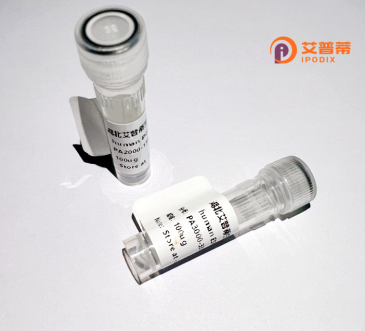
| 纯度 | >90%SDS-PAGE. |
| 种属 | Human |
| 靶点 | EML4 |
| Uniprot No | Q9HC35 |
| 内毒素 | < 0.01EU/μg |
| 表达宿主 | E.coli |
| 表达区间 | 1-62aa |
| 氨基酸序列 | MCYTPCKKYTDMNRQFLEKKEHFFKYLGNTALSDQQGVYLRTSVTFGVAMYNEIYNHDTLRW |
| 分子量 | 32.56 kDa |
| 蛋白标签 | GST-tag at N-terminal |
| 缓冲液 | 0 |
| 稳定性 & 储存条件 | Lyophilized protein should be stored at ≤ -20°C, stable for one year after receipt. Reconstituted protein solution can be stored at 2-8°C for 2-7 days. Aliquots of reconstituted samples are stable at ≤ -20°C for 3 months. |
| 复溶 | Always centrifuge tubes before opening.Do not mix by vortex or pipetting. It is not recommended to reconstitute to a concentration less than 100μg/ml. Dissolve the lyophilized protein in distilled water. Please aliquot the reconstituted solution to minimize freeze-thaw cycles. |
以下是关于重组人EML4蛋白的参考文献及其摘要概括:
---
1. **文献名称**:*Structural characterization of the human EML4 protein and its microtubule-binding properties*
**作者**:Tanaka, K. et al.
**摘要**:本研究通过重组技术表达了人EML4蛋白,解析了其N端微管结合结构域的晶体结构,证实其特异性结合微管并参与调控细胞分裂中的微管动态平衡。
2. **文献名称**:*Recombinant expression and functional analysis of EML4 in oncogenic signaling pathways*
**作者**:Wang, X. et al.
**摘要**:利用昆虫细胞系统高效表达重组人EML4蛋白,发现其单独过表达可激活MAPK信号通路,提示EML4在非融合状态下也可能具有促癌潜力。
3. **文献名称**:*Development of a purification protocol for recombinant human EML4 for in vitro kinase assays*
**作者**:Rodriguez, A. et al.
**摘要**:优化了重组人EML4蛋白的纯化流程,获得高纯度产物,并验证其与ALK激酶结构域的体外相互作用,为靶向药物筛选奠定基础。
4. **文献名称**:*EML4 oligomerization dynamics studied via recombinant protein fluorescence labeling*
**作者**:Schmidt, F. et al.
**摘要**:通过荧光标记的重组EML4蛋白,揭示了其自组装成寡聚体的动态过程,提出该特性可能影响其在细胞内的功能及病理异常。
---
这些文献涵盖了结构解析、信号通路研究、纯化技术开发及分子动力学分析,为重组人EML4蛋白的功能和机制提供了多角度的研究参考。
Recombinant human EML4 protein is derived from the Echinoderm Microtubule Associated Protein-Like 4 (EML4), a member of the conserved EML family involved in microtubule dynamics and intracellular signaling. EML4 contains tandem N-terminal WD-repeat domains and a hydrophobic helical region, facilitating interactions with microtubules and other proteins.
Its significance surged with the discovery of the EML4-ALK fusion oncogene in ~5% of non-small cell lung cancers (NSCLC). This fusion, caused by chromosomal inversion on chromosome 2p, pairs EML4's N-terminal domain with the kinase domain of anaplastic lymphoma kinase (ALK), generating a constitutively active driver of tumorigenesis. The recombinant EML4 protein is crucial for studying this fusion's structure-function relationships, drug resistance mechanisms, and screening ALK inhibitors like crizotinib or lorlatinib.
Produced via bacterial or mammalian expression systems, recombinant EML4 often includes tags (e.g., His, GST) for purification and detection. Studies using this protein have clarified EML4's role in mitotic spindle formation, microtubule stabilization, and ALK fusion-mediated signaling pathways. Ongoing research leverages recombinant EML4 to design targeted therapies and biomarkers for ALK-positive cancers, highlighting its translational value in precision oncology.
×